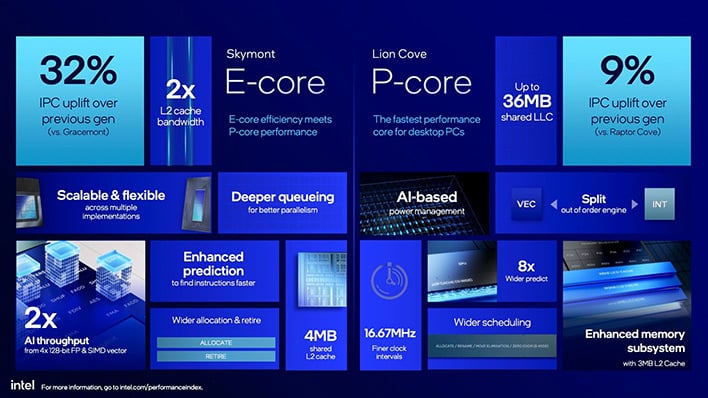The Core Ultra 200S series’ tiles are linked together by a fast interconnect and built with 3D Foveros packaging, which the company initially employed for Meteor Lake as well. This is a chip-stacking technology that allows different kinds of logic to be more efficiently configured for maximum silicon real estate management and deeper integration.
Just like the company’s Lunar Lake mobile CPUs, Intel’s Lion Cove architecture powers the P-cores of the Core Ultra 200 series. Pretty much everything from our previous coverage rings true today. Gone is Intel’s symmetric multi-threading (SMT) technology known as Hyper-Threading. Intel feels it is better to recover the silicon used to implement the feature (which includes scheduling and other support logic on top of SMT itself) and instead focus on the best single-threaded performance it could manage.
As with the previous generations, the CPUs are divided into numbered lines: Core Ultra 9, Ultra 7, and Ultra 5, and each tier has a different configuration in terms of the number of CPU cores of both P- and E- variants. The Core Ultra 9 285K is the current flagship with eight P-cores and 16 E-cores for a total of 24 hardware threads with access to 36MB of L3 and 40MB of L2 cache. This CPU tops out at 5.7 GHz, which is down a few notches from the 6.2 GHz of the Core i9-14900KS. Still, with architectural improvements we expect the Core Ultra 9 285K to beat out the prior-gen in a few areas.
As has been customary, Intel provides a couple of different model types. The CPUs that end with K are the top of each range, and these chips have functional GPU tiles. Meanwhile, the models that end in KF have no GPU. As we’ll see in a moment, these chips will be a little cheaper than the K models, but it’s not that much of a break. The GPU is a mature original Xe graphics design with just four Xe-cores, but Intel expects these chips to be paired with discrete GPUs most of the time.
The Core Ultra 7 265K and KF CPUs lose four E-cores but retain the octet of P-cores, and feature 30MB of L3 and 36MB of L2 cache. They also top out at a slightly lower 5.5 GHz. Meanwhile, the Core Ultra 5 245K loses two P-cores and four more E-cores for a total of 14 threads, with 24MB and 26MB of L3 and L2 cache respectively. It also tops out at a lower 5.2 GHz clock speed.
From a pricing standpoint, the Core Ultra 200S processors aren’t that much different than the previous generation. The Core Ultra 285K should be the same $589 that the Core i9-14900K launched at. The Core Ultra 7 265K drops the price by 33% down to right below $400. Thanks to its relative similarity to the top-end model, it’s definitely a value target. The Core Ultra 5 245K and KF are in the same $300 range as the previous generation, but with a rather steep dip in thread counts, so it’ll be interesting to see how performance plays out.
In terms of their physical appearance, the new Core Ultra 200S series processors look much like their predecessors, but they utilize a new socket, and the disaggregated design introduces a bit of nuance when it comes to cooling. The Core Ultra 200S requires new chipsets (more on the next page) and the LGA 1851 socket – these aren’t a drop-in upgrade for existing platforms.
The heatspreader uses a similar design and thermal interface material to 14th Gen processors, but the positioning of the tiles underneath the heat spreader means the most power-hungry tile, the compute tile, is a bit offset from previous designs. The new socket and processors are compatible with existing coolers for the 13th and 14th Core processors, but you’ll see some vendors coming out with “offset plates” to ensure the center of the heat plates on their coolers lines up better with the hot spot on the processors. Those offset plates are not a requirement at all, but for enthusiasts that want optimal thermals, it’s something to keep in mind.




